A robot revolution is well underway, driven by core technologies


When the internal combustion engine became reliable and dropped in price in the early 20th century, the technology began to see broad adoption both inside and outside transportation. Engines were used to pump water, create electricity, and power factories. The steam age quickly gave way to the age of combustion, and the modern world sprang into existence.
We're seeing a similar pattern in robotics as core technologies, such as sensors and encoders, become cheaper and more reliable, leading to an explosion in the number of robotics applications.
Operating systems that power robots are key in this sense. ROS, the Robotic Operating System, has been foundational in robotics development, offering an open-source ecosystem for developers to create robots of striking diversity. We're also starting to see proprietary third-party operating systems that used to power an array of robotics applications that might otherwise take years of development to bring online.
The operating system is the all-important Lego block around which diverse robotics platforms are built up.
A San Diego-based AI company called Brain Corp, which we've written about before, offers a case in point of how an OS becomes an extensible base technology that spurs rapid development in the sector. Brain Corp makes BrainOS, a commercial operating system for the production and deployment of autonomous mobile robots (AMRs). The technology was first developed to clean floors, and it powers several scrubbing robots in the floor care industry, including those made by Tennant, Minuteman, ICE, and SoftBank Robotics.
But the same system that enables a floor scrubber to safely traverse an office building can of course be used to power a different kind of autonomous mobile robot. That's just what's happening. BrainOS has now been used in an autonomous stock delivery robot.
The robot, a tug that pulls carts of various sizes, can be utilized by grocery stores, for example, to pull stock to various locations. The automated delivery solution can be customized for commercial and retail facilities, as well as warehouses and factories.
"This planned expansion beyond floor care and into the delivery space has primed BrainOS to become the industry standard when building AMRs," says John Black, Brain Corp's Senior Vice President of New Product Development. "Cited as the world's top Autonomy Solution Provider by ABI Research, BrainOS and its promise of form factor and application flexibility is well represented through our introduction of AutoDelivery."
That flexibility is at the heart of the current robot revolution, which is well underway, even if we don't all have a home robot serving up breakfast while shuttling the kids off to school.
"The integration of BrainOS into not just another form factor, but an entirely new vertical outside of floor care further proves the robustness and extensibility of the BrainOS platform," says Brain Corp Co-Founder and CEO, Dr. Eugene Izhikevich.